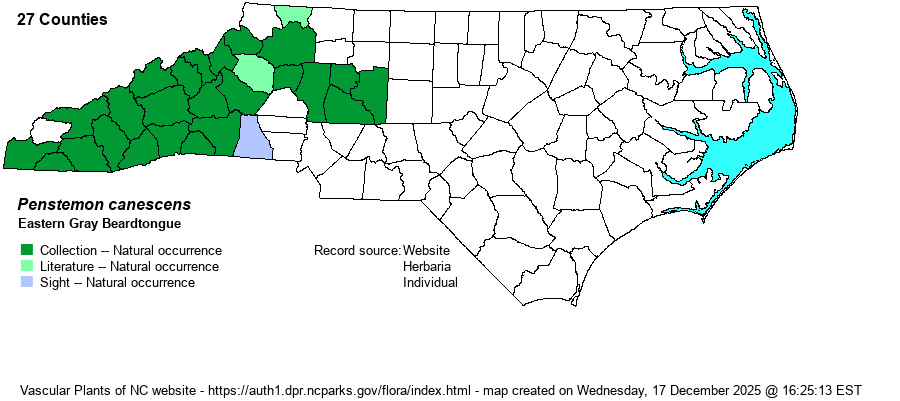| Author | (Britton) Britton | |
| Distribution | Throughout the Mountains, lacking specimens for just three counties. Also ranges to the central Piedmont, east to Davidson County, but scarce in the southwestern Piedmont.
This is primarily a species of the central and southern Appalachians, and into the Piedmont (mainly north of NC); ranges from PA and southern IL south to central AL. | |
| Abundance | Common over most of the Mountains, being the most numerous Penstemon in that province. Uncommon in the west-central Piedmont, and probably north to the VA border (though records lacking in some of these northwestern Piedmont counties, but widespread just over the border in VA). Rare in the southwestern Piedmont. The editors has justifiably re-ranked the species as S4. | |
| Habitat | This is a wide-ranging species of a variety of dry to dry-mesic upland habitats in the western part of the state. It occurs along dry roadbanks, margins of upland woods, on rocky slopes, open and dry woodlands, and even along roadsides. | |
| Phenology | Blooms from May to July, and fruits shortly after flowering. | |
| Identification | This is a standard-looking Penstemon, being an erect herb growing to about 1.5 feet tall. The stem is generally somewhat hairy, especially in the upper half. The scattered pairs of opposite stem leaves tend to be lanceolate, with rounded to truncate bases and sessile, essentially clasping the stem (like in most others in the genus). The leaves average about 3.5-4 inches long and about 1-1.5 inches wide, clearly serrated on the margins, and generally pubescent on both surfaces. This species has a pair of large leaf-like bracts just below the inflorescence, but the other nodes above this, where the flowers come off the stem, have only very small and slender bracts. The many flowers are purple-rose, somewhat inflated on the throat, and about 1.3 inches long, with the upper corolla lobes being shorter than the lower ones. The hairy upper stem and leaves should separate this from the very rare P. calycosus, the paler-flowered P. laevigatus, and P. smallii. P. smallii is quite similar, but that species has essentially smooth leaves, and each of the whorls within the inflorescence has a clearly leaf-like (large) bract, rather than a small and narrow bract. You should run into both P. canescens and P. smallii fairly often in the mountains, with the latter being the less numerous. If inflorescences are not seen, the identification can be trickier, but normally with keys and a hand lens you likely can make an identification. | |
| Taxonomic Comments | None
| |
| Other Common Name(s) | Appalachian Beardtongue | |
| State Rank | S3 [S4] | |
| Global Rank | G4 | |
| State Status | | |
| US Status | | |
| USACE-agcp | | |
| USACE-emp | | |

